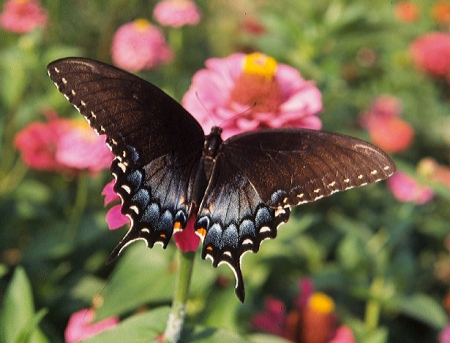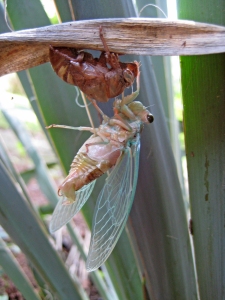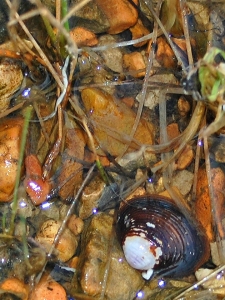“What is your favorite butterfly?” I am asked that question by both children and adults. So many of our butterflies are beautiful in both color and grace, so it can be difficult to pick just one to say its your “favorite.” Sometimes a favorite butterfly has a deeper, more personal meaning.

Black Swallowtail Caterpillar
Maybe it’s just this time of year when the butterflies and wildflowers really begin to thrive, or maybe I’m just feeling sentimental, but when I see a swallowtail, I still feel like a little kid. My first butterfly was a black swallowtail, so for this and other reasons, it remains my personal favorite. Sorry, my beloved Diana fritillary, you are somewhat second when it comes to being my first love.

Black Swallowtail Butterfly
My love of butterflies began with a fifth-grade homework assignment. I am still in contact with my teacher. To a little kid, a caterpillar tucked into an empty pickle jar with a bunch of unidentified leaves wasn’t an epiphany until the black swallowtail emerged eight months later. Then, as my father can corroborate, I was hooked.
As I watch our swallowtails flit through the air, I do look at them with the eyes of an educated adult, but I still have a sense of awe and wonder. The swallowtails living in Arkansas are such amazing creatures, and you can enjoy them in both your yard and in our state parks.

Mud-puddling Zebras and Pipevine Swallowtails
Swallowtails on the wing in May include black, pipevine, zebra, Eastern tiger, spicebush, and giant swallowtails. Since more people are adding both nectar and host plants to their home gardens, more people are looking and attracting these insects. One of the best parts of my job is to give someone advice one year, and then listen to their success stories in the following years.
Perhaps one of the best examples of attempting to live in harmony with butterflies is the gardener who puts up with black swallowtail caterpillars on their parsley, dill, and fennel. To begin life resembling a bird dropping assures some demise. If only they started life as their mature yellow-green color, and if only they wouldn’t chow down on the same leaves we want to eat so rapidly! For this reason, I grow Queen Anne’s lace, just in case I need to transfer caterpillars.

Dark Form Female Tiger Swallowtail
More gardeners are becoming interested in growing Dutchman’s pipevine for pipevine swallowtails. This shade plant contains chemicals that once ingested, help defend both caterpillar and adult from hungry predators. Pipevine swallowtails are often the first swallowtail to emerge in spring, and have multiple generations in one year. Their iridescence is unmatched in the sunlight.
The tails of zebra swallowtails are longer in the summer form than the spring form, and both are master of dizzying flight maneuvers.
To study one or all of the swallowtails is a lifetime of fun in itself. For me, seeing a large butterfly with tails always makes my day a little brighter.
Just this week, I spent a mere 30 minutes standing in one spot on Will Apple’s Road Trail at Mount Magazine State Park, and saw a flurry of activity. A pipevine swallowtail unsuccessfully attempted to court a red-spotted purple. Talk about mistaken identity! A female giant swallowtail was flitting from hop tree to hop tree (aka wafer ash), searching for a suitable place to lay eggs. A dark-form female tiger swallowtail flew into the courtship of the other two black butterflies and disrupted them. A satyr flew by my head. I flushed a red-banded hairstreak from the ground. A fresh silver-spotted skipper was basking in the sunlight near its host plant, a black locust almost in fragrant full bloom. The pipevine swallowtail gave up the courtship and flew away. The red-spotted purple finally alighted on a cherry tree and basked in a sliver of sunlight. Everyone benefits by immersing themselves in a natural setting such as this. It frees the heart and mind.
One of the amazing aspects of nature is the symbiotic relationship between wildflowers and their butterfly pollinators. Later this May, male Diana fritillaries emerge from their chrysalises, with females following approximately three weeks later. This is well synchronized with the blooming of butterfly weed, purple coneflower, bee balm, and several others.

Kids really enjoy the Mount Magazine Butterfly Festival!
Arkansas has many butterfly “hot spots,” and special events designed to help visitors enjoy them more. The Mount Magazine Butterfly Festival, coming up June 25-26, is dedicated to creating awareness of butterflies in their natural habitat and their importance as pollinators. The weekend is full of programs, hikes, children’s games and crafts, a live arthropod zoo, garden tours, and two concerts. It is a great way for families to spend a weekend together.
I think I’ll head outside and check my parsley (again) for black swallowtail caterpillars. I’m still a little kid at heart who would much rather be outside.

Lori Spencer, Certified Heritage Interpreter
Lori Spencer is the author of Arkansas Butterflies and Moths, and has won multiple awards for volunteer work at Mount Magazine State Park and throughout Arkansas. Since she moved to Arkansas in 1992, Lori has been an active voice for creating awareness about Arkansas’s rich butterfly heritage and their conservation needs. She has been associated with the Mount Magazine Butterfly Festival since its inception in 1997. She volunteers for four different organizations, including Logan County Master Gardeners, the Mount Magazine Action Group, and the National Association for Interpretation, and is both the Arkansas and Louisiana coordinator for the Butterflies and Moths of North America website. She holds a bachelor’s degree from Central College in Pella, Iowa, and a master’s degree in entomology from the University of Arkansas. She is both a Certified Heritage Interpreter and Certified Interpretive Guide. She received a national conservation award by the Daughters of the American Revolution recently.







 Posted by Arkansas State Parks
Posted by Arkansas State Parks 





 Facebook
Facebook Twitter
Twitter YouTube
YouTube
